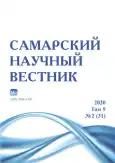Видовой и ценотический состав фитоценозов отвалов юрских глин келловейского яруса Михайловского горно-обогатительного комбината Курской магнитной аномалии
- Авторы: Головастикова А.В.1, Нагорная О.В.2
-
Учреждения:
- Курский институт кооперации (филиал) Белгородского университета кооперации, экономики и права
- Курская государственная сельскохозяйственная академия имени И.И. Иванова
- Выпуск: Том 9, № 2 (2020)
- Страницы: 42-47
- Раздел: Общая биология
- URL: https://journals.rcsi.science/2309-4370/article/view/41918
- DOI: https://doi.org/10.17816/snv202107
- ID: 41918
Цитировать
Полный текст
Аннотация
В статье представлены результаты исследований скорости зарастания отвалов юрских глин келловейского яруса Михайловского горно-обогатительного комбината Курской магнитной аномалии травянистой и древесно-кустарниковой растительностью. Выявлены особенности зарастания отвалов различного времени отсыпки (5, 15, 25 лет) и характер зарастания различных экспозиций отвалов. Проведенные исследования показали, что к 5-летнему возрасту на глине келловея формируется пионерная группировка, где доминантными видами являются мать-и-мачеха Tussilago farfara L. и хвощ луговой Eguisetum pratense Ehrh. К 15-летнему возрасту формируется зарослево-групповое сообщество, относящееся к категории простых, так как представлено единичными видами или имеет куртинный характер зарастания с небольшим количеством сорных и луговых видов. Установлено, что к 25-летнему возрасту преобладающими типами зарастания являются группово-зарослевые сообщества, где виды-эдификаторы – береза повислая Betula pendula Roth и сосна обыкновенная Pinus sylvestris L. имеют разреженный характер распространения. Выявлено, что участки, занятые травянистой растительностью, на 25-летних отвалах имеют в основном куртинный характер зарастания и представлены монодоминантными сообществами донника лекарственного, который имеет двухлетний период развития. С периодичностью в год, при доминировании мать-и-мачехи и одуванчика лекарственного Taraxacum officinale L., проективное покрытие достигает ста процентов. Ряд рудеральных и луговых видов: тысячелистник обыкновенный Achillea millefolium L., мать-и-мачеха, кипрей узколистый Chamerion angustifolium L., пастернак лесной Pastinaca sylvestris Mill., одуванчик лекарственный, полынь равнинная Artemisia compestris L., мятлик луговой Poa pratensis L. имеют относительно разреженное распространение. Дополнительно описано распространение видов в зависимости от экспозиции склонов. По всем отвалам представлен видовой состав, проективное покрытие, количество растений и видов на 1 м². Установлена зависимость ценотического состава растительности от возраста отвалов.
Ключевые слова
Полный текст
Открыть статью на сайте журналаОб авторах
Антонина Валентиновна Головастикова
Курский институт кооперации (филиал) Белгородского университета кооперации, экономики и права
Email: golovastikova.a.v@mail.ru
кандидат сельскохозяйственных наук, доцент кафедры товароведно-технологических дисциплин
Россия, КурскОльга Вячеславовна Нагорная
Курская государственная сельскохозяйственная академия имени И.И. Иванова
Автор, ответственный за переписку.
Email: nagornayaov@yandex.ru
кандидат биологических наук, доцент кафедры экологии, садоводства и защиты растений
Россия, КурскСписок литературы
- Шилов И.А. Биоценология: учебник для вузов. М.: Изд-во Юрайт, 2020. 184 с.
- Стифеев А.И., Головастикова А.В. Биопедоценоз как показатель экологического состояния техногенного ландшафта // Экология. 1999. № 6. С. 449–454.
- Стифеев А.И., Головастикова А.В. Формирование фитоценозов на техногенных ландшафтах МГОКа // Флора и растительность северной лесостепи: мат-лы науч.-практ. конф. 17 января 2002 г. / отв. ред. Н.И. Золотухин, Тула: ИПП «Гриф и К°», 2002. С. 22–23.
- Нешатаев Ю.Н. Методы анализа геоботанических материалов. Л.: Изд-во ЛГУ, 1987. 188 с.
- Программа и методика биогеоценологических исследований / отв. ред. Н.В. Дылис. М.: Наука, 1974. 403 с.
- Воронов А.Г. Геоботаника: учеб. пособие для биол. и геогр. специальностей ун-тов и пед. ин-тов. 2-е изд., испр. и доп. М.: Высшая школа, 1973. 384 с.
- Колесников Б.П., Моторина Л.В. Методы изучения биогеоценозов в техногенных ландшафтах: программа и методика изучения техногенных биогеоценозов. М.: Наука, 1978. С. 5–21.
- Шенников А.П. Введение в геоботанику: учеб. для биол. фак. ун-тов. М.: Изд-во МГУ, 1964. 447 с.
- Маевский П.Ф. Флора средней полосы европейской части России: учеб. пособие для биологических факультетов университетов, педагогических и сельскохозяйственных вузов. 11-е испр. и доп. изд. М.: Товарищество научных изданий КМК, 2014. 635 с.
- Губанов И.А., Киселева К.В., Новиков В.С., Тихомиров В.Н. Иллюстрированный определитель растений Средней России. Т. 3: Покрытосеменные (двудольные: раздельнолепестные). М.: Товарищество научных изданий КМК, 2004. 520 с.
- Черепанов С.К. Сосудистые растения СССР / отв. ред. А.А. Федоров. Л.: Наука: Ленингр. отд-ние, 1981. 510 с.
- Муха В.Д., Стифеев А.И., Головастикова А.В. Особенности почвообразования в техногенных ландшафтах КМА // Земельные ресурсы Украины: рекультивация, региональное использование и охрана: мат-лы науч.-практ. конф. Днепропетровск: ДГАУ, 1996. С. 94–95.
- Раменский Л.Г. Введение в комплексное почвенно-геоботаническое исследование земель. М.: Сельхозгиз, 1938. 620 с.
- Капелькина Л.П. О естественном зарастании и рекультивации нарушенных земель севера // Успехи современного естествознания. 2012. № 11 (1). С. 98–102.
- Головастикова А.В. Оценка биогеоценозов в техногенных экосистемах // Дни науки: мат-лы XI междунар. науч.-практ. конф. 30 марта – 7 апреля 2015 г. / отв. ред. M. Wilson. Прага, 2015. С. 45–48.
- Сафонов Г.Е., Прудников Н.А. Охраняемые растения и ботанические памятники природы Курской области. Курск: КГУ, 1992. 38 с.
- Головастикова А.В. Использование техногенных ландшафтов в сохранении видового богатства северной лесостепи // Экология и образование: тез. докл. науч.-практ. конф. Курск: КГУ, 1994. С. 17–18.
- Анянова Е.В., Крайнова Т.С., Воронов М.П. Проблема рекультивации земель, нарушенных в процессе угледобычи // Научное обозрение. Биологические науки. 2016. № 3. С. 36–46.
- Головастикова А.В. Фитоценозы 25-летних отвалов Михайловского ГОКа железорудного карьера КМА (глин келловейского яруса) и возможности их использования // Вестник Курской ГСХА. 2019. № 3. С. 22–26.
- Куприянов А.Н., Морсакова Ю.В. Естественное зарастание отвалов Кузбасса // Вестник Кузбасского государственного технического университета. 2006. № 3 (54). С. 48–51.
Дополнительные файлы







